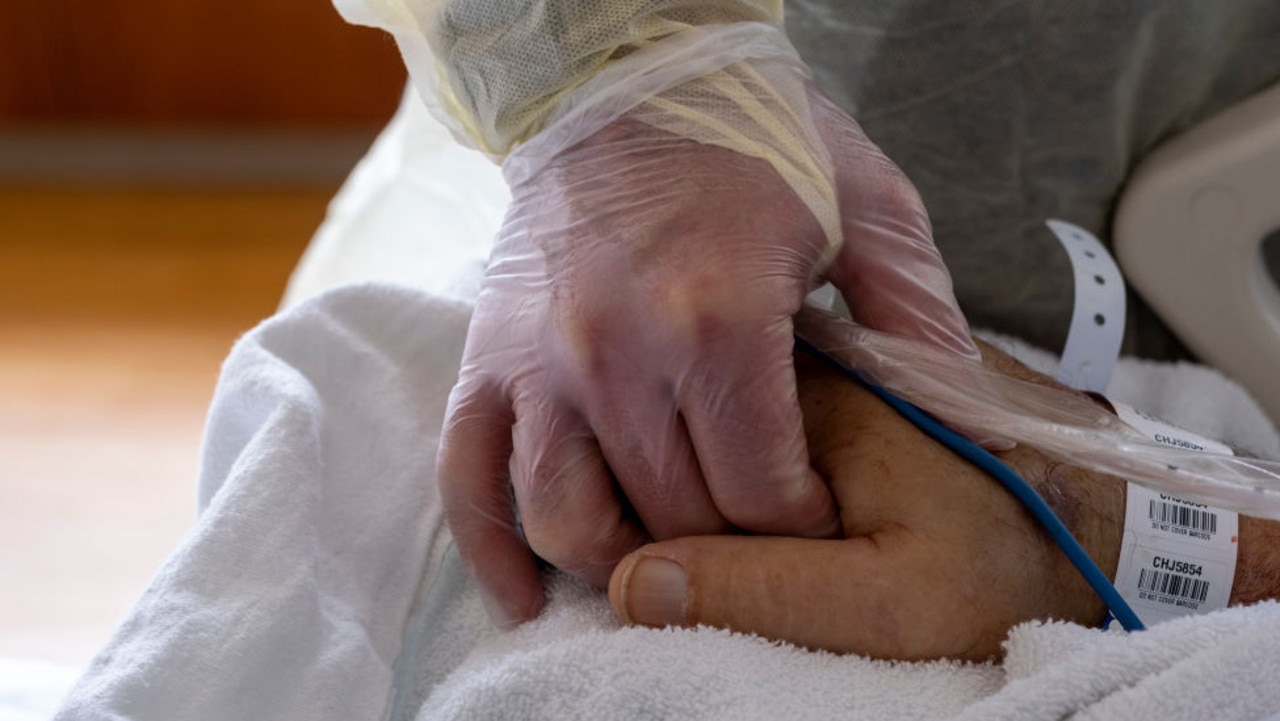Nurse shares what Covid does to your body
Hospital worker Karen Gallardo has shared the horrific stages of a serious Covid-19 case – and how rapidly it can claim a life.
The horrific seven stages a Covid-19 patient endures before succumbing to the disease has been detailed by a hospital employee, in a stark reminder of just how rapidly the virus can claim a life.
Respiratory therapist Karen Gallardo revealed in a piece for the LA Times how time and again, she watched Covid patients admitted to the hospital only to be forced to farewell their loved ones via a video call.
As the Delta variant wreaks havoc across the globe and patients desperate for treatment continue to climb, Ms Gallardo has shared what people can expect from a serious case of Covid-19 if they don’t get vaccinated.
Those who contract the virus despite being vaccinated, would generally recover after the first stage of symptoms, she said.
STAGE 1: Ms Gallardo said the first stage came after patients had already experienced symptoms for a few days and were beginning to struggle with breathing. At that point, they were generally admitted to the emergency department with poor oxygen saturation levels.
Staff then usually got patients started on a cocktail of treatments, including antivirals, steroids, and anticoagulants or monoclonal antibodies.
If those were effective, the patient would slowly be taken off oxygen and eventually be discharged. If not, they would progress to the next stage of the disease.
STAGE 2: By the second stage, patients would normally begin experiencing a “drowning” sensation, with the administration of bronchodilator treatments only providing slight relief.
Patients would tend to require even more oxygen, typically in increments from 4-litres to 15-litres to 40-litres per minute, Ms Gallardo said.
At this point, patients needed help with things like using the bathroom and even sitting up in bed, and generally their oxygen saturation declined when they moved around.
People who didn’t improve at this stage would be transferred to the intensive care unit.
STAGE 3: Patients in the third stage of serious symptoms became exhausted just through their desperate effort of trying to inhale enough air to survive, Ms Gallardo said.
The struggle was partially alleviated with a “big, bulky face mask” she said, that had to be tightly strapped to the face to force pressure into the lungs so oxygen could be delivered to them.
STAGE 4: Breathing typically became even harder in the fourth stage, with patients becoming “severely fatigued” and the oxygen in their blood getting “critically low”.
As staff prepared to intubate the patient, Ms Gallardo said they were sometimes, if time permitted, given an opportunity to call their loved ones, possibly for the final time.
Patients were then sedated and hooked up to a ventilator, fed through a feeding tube, hooked to a Foley catheter and a rectal tube, with hospital staff needing to turn the body to avoid it developing ulcers and bed sores.
It was also up to hospital staff to bathe the patients, and often, experiment with therapeutics to help them.
STAGE 5: Patients who survive the fourth stage of the disease can only have their condition improve with the assistance of an ECMO machine, which not all hospitals have.
Ms Gallardo said the machine worked by bypassing the patient’s lungs to oxygenate their blood, but they often needed to be transferred to another hospital for the treatment.
Failing that, medical staff would have no choice but to continue treatments with what they had available to them.
STAGE 6: The body of any patient who progressed to this stage was so strained that it was simply incapable of surviving without invasive intervention, Ms Gallardo said.
Tubes were required in the chest cavity to clear air that had leaked out from the pressure placed on the lungs, while the kidneys became unable to filter out by-products from all the drugs.
No amount of diuretics was capable of reducing the body’s swelling, she added, with dialysis required to sustain its renal function.
At this stage, it was near impossible to avoid complications, given the patient’s immune system had been extensively weakened.
Blood clots and fluid accumulation in their lung sacks was also common, along with critical drops in blood pressure which might not always be effectively treated with vasopressors.
Ms Gallardo said even if staff were immediately treating every complication that arose, the patient’s heart “may stop anyway”, leaving their family to “make a difficult decision”.
STAGE 7: Patients who survive past the sixth stage sadly don’t make it any further, with their family and the palliative care team discussing how to go about planning the end of their life.
Ms Gallardo said patients were then relieved of their breathing machinery and tubes for a final video call with their loved ones.
“As we work in your room, we hear crying and loving goodbyes. We cry, too, and we hold your hand until your last natural breath,” Ms Gallardo said.
She said despite having witnessed the gut-wrenching symptomatic stages throughout the last gruelling 17 months, “it doesn’t get easier”.
“My pandemic stories rarely end well,” she said.
For all the latest lifestyle News Click Here

